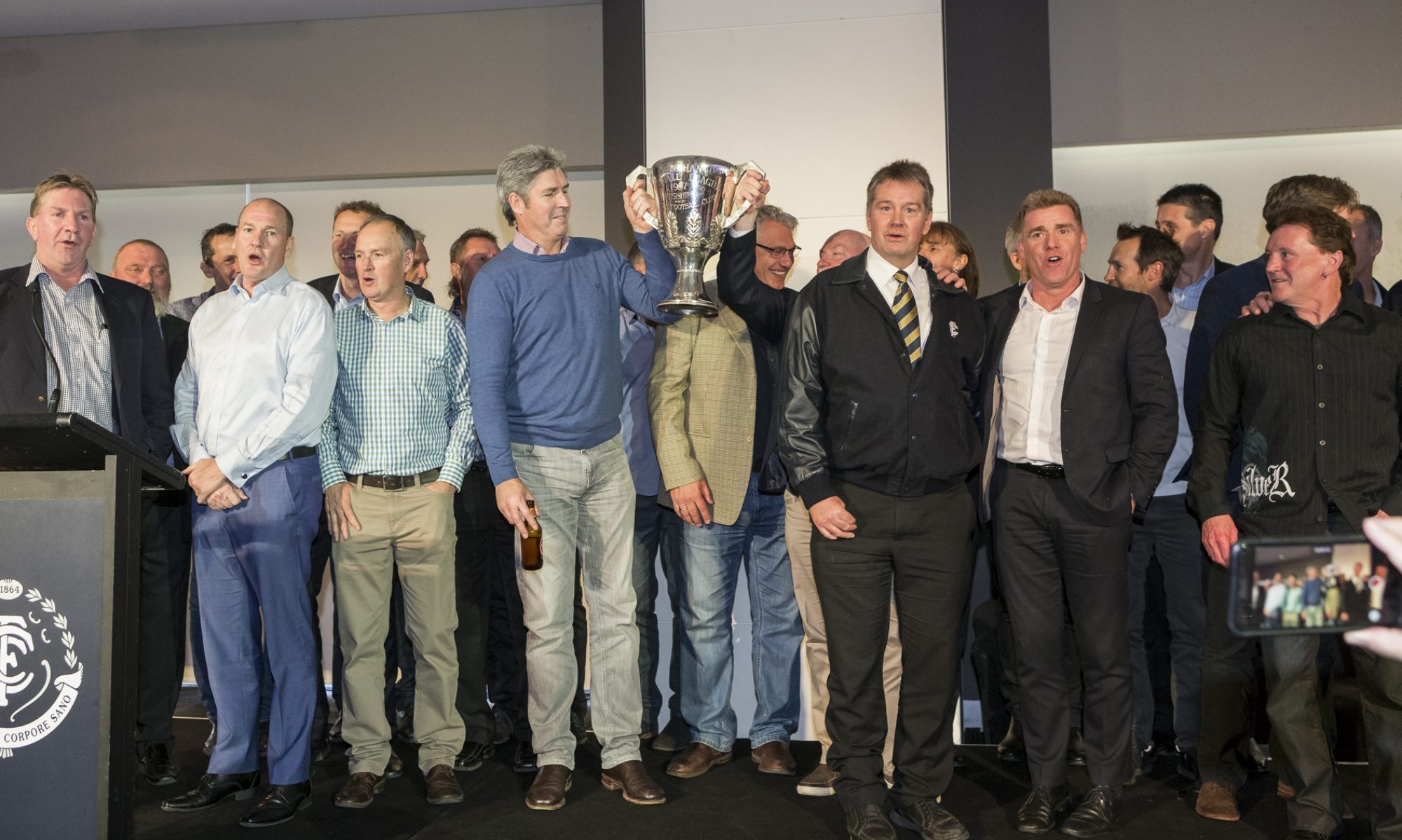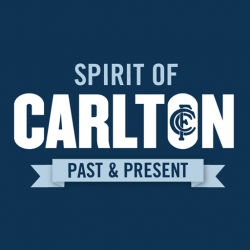Des English
 Career : 1980 – 1987
Career : 1980 – 1987
Debut : Round 4, 1980 v South Melbourne
Carlton Player No. 884
Games : 104
Goals : 6
Last game: Grand Final, 1986 v Hawthorn
Guernsey No. 27
Height : 178 cm
Weight : 86 kg
DOB : October 9, 1957
Premiership Player : 1981 & 1982
Another in a long line of courageous, reliable and tough back-pockets for the Blues, Des English was a valuable contributor in three Carlton Grand Final teams, including the 1981 and ’82 Premiership sides. One of the most respected players of his era, he was, sadly, forced into premature retirement when he was diagnosed with leukaemia.
English came to Carlton from Bendigo League club Eaglehawk in 1980, following in the footsteps of champion rover Rod Ashman. Like “Ashy”, Des had also won the Two Blues’ Best & Fairest award, and was a regular Bendigo League representative, usually at half-back. At Carlton he found a niche in the back pocket, and began consolidating his place in one of the league’s power teams.
Carlton finished the 1980 home and away season in second place, but lost both finals matches in successive weeks. It was a bitterly disappointing end to a bad year for the Blues, only compensated by the belief that this team was much better than its results might indicate. The Blues knew that they had the talent and the drive to win another Premiership – all they needed was the opportunity.
Under new coach David Parkin, that opportunity wasn’t long in coming. Carlton played brilliantly all season in 1981, topping the home and away ladder on percentage over Collingwood, then going on to beat the Magpies by 20 points on Grand Final day. The Blues’ defence, boasting the names Doull, Hunter, McKay, Harmes and Perovic, was topped off with the emergence of Des English. At 178 cm and 88 kg, Des was solid enough to handle any physical pressure, and tall enough to fill a variety of defensive roles. An safe mark, cool under pressure and an accurate disposer of the ball, he won new fans each week with his rock-solid consistency.
In 1982 he won his second Premiership medal when Carlton triumphed again over their other traditional rival, Richmond. The free-scoring Tigers started warm favourites in that year’s decider, but with captain Mike Fitzpatrick supreme in the ruck, and Bruce Doull impassable at half-back, The Blues won their fourteenth flag by 18 points. Two Premierships in his first three seasons was a dream come true for English. The 26 year-old was in the best form of his life, and a fixture in one of the great football teams.
Rod Galt: Happy 60th Birthday!
 Career : 1975 –1979
Career : 1975 –1979
Debut : Round 17, 1975 vs Hawthorn, aged 23 years, 290 days
Carlton Player No. 855
Games : 46
Goals : 100
Last Game: Round 21, 1979 vs Collingwood, aged 27 years, 320 days
Guernsey No. 17
Height : 194 cm (6 ft. 4½ in.)
Weight : 92 kg (14 stone, 7 lbs.)
DOB : October 9, 1951
Leading Goalkicker: 1978
Rod “Spook” Galt was an athletic, talented ruckman-forward who was recruited by Carlton from St. Kilda in 1975. Although he ended up playing a combined total of 123 games with the Blues and the Saints, it must be said that he was never the most committed individual at either club, and his somewhat lackadaisical attitude caused frustration throughout his career. But if Galt’s football journey was not particularly rewarding, it was certainly varied.
Nicknamed “The Ghost” or “Spook” because of his slim build, pale complexion and shock of white-blonde hair, Galt was recruited by St Kilda from bayside Beaumaris in 1971. He was a minor sensation in his first season, and after an impressive finals series in which St Kilda fought their way right through to the Grand Final (only to fall to Hawthorn by 7 points) one newspaper dubbed him “the new Carl Ditterich.”
However, the inconsistency that would plague his career soon appeared, and by the end of 1974 the Saints had had enough. They kept him on their list, but sent him to play in Darwin for the first few months of 1975 while they decided his future. When he was recalled mid-year, he was informed that his contract had been purchased by Carlton, and from that point on he was a Blue.
Wearing the number 17 guernsey recently discarded by Brent Crosswell on his way to North Melbourne, Galt played his first senior match for his new club against Hawthorn at Princes Park in round 17, 1975 – a cracker of a contest that Carlton lost by just 4 points. Despite that narrow margin, Galt was left out of the team the following week, and spent the rest of the year with the Reserves.
He began 1976 impressively; booting three goals and rucking strongly in Carlton’s big win over Collingwood at Princes Park in round 1. Another five matches in a row followed, before he was omitted again and managed just one more senior appearance by year’s end. In 1977 he fared little better. After playing three of the first six games, he was sent back to the seconds again and his future with the Blues looked bleak – until another chain of events began in June of that year, when he and three other senior-listed Blues were briefly “loaned” to a struggling Bendigo League club for one match.
The team concerned was Kennington, who hadn’t won a game all year. On the brink of disbanding, they were about to face the undefeated ladder-leaders Eaglehawk and were praying for a miracle. At the time the Bendigo area was Carlton’s prime recruitment zone, so the Carlton committee decided to give Kennington a hand by strengthening them with four senior-listed Blues for the match. Rod Galt, Gary Conn, Peter Halsall and Lou Chiodo all duly played in the game, but Eaglehawk still won easily.
After that, Galt was on the move again – this time to Western Suburbs in Sydney, where his presence was more telling. He settled into life in the Harbour City, rediscovered his best form, and topped off a memorable few months by dominating the Grand Final. Western Suburbs kicked 14.15 to North Shore’s 5.2 in the second half of that Premiership decider, with Galt clearly best on ground in leading his team to a comprehensive victory.
Perhaps it was that performance that saved his VFL career, or maybe an ultimatum was put to him by the Blues. Whatever it was that transpired over the summer of 1977-78, it certainly worked – because “Spook’ re-emerged as a league footballer and had by far his best season. Playing as an almost permanent forward pocket, his height and aerial skills were tough to counter, and his accuracy in kicking for goal was deadly. In a purple patch of form between rounds 9 and 12, 1978, Galt kicked three bags of six goals each, as Carlton bounced back from a poor year in ’77 to once again qualify for the finals in fourth spot on the ladder.
Enjoying his first VFL final since leaving St Kilda, Spook booted three goals in the Blues’ good win over Geelong in the ‘78 Elimination Final, and notched another three the following week when Carlton’s season concluded with a loss to Collingwood in the first Semi. In the process, he finished the year with an aggregate of 49 majors to take out Carlton’s Leading Goal-kicker award, and paved the way for a shift to full-forward the following year.
Dick Vandenberg
Career : 1966
Debut : Round 13, 1966 vs St Kilda, aged 18 years, 287 days
Carlton Player No. 788
Games : 3
Goals : 2
Guernsey No. 8
Last Game: Round 15, 1966 vs Essendon, aged 18 years, 301 days
Height : 183 cm (6 ft. 0 in.)
Weight : 80 kg (12 stone, 8 lbs.)
DOB : October 9, 1947
Richard ‘Dick’ Vandenberg played three consecutive games and kicked 2 goals for Carlton in 1966. A tall rover-forward, he was recruited from Robinvale, and allocated guernsey number 8 in the second year of Ron Barassi’s tenure as captain-coach of the Blues.
After making a good impression at Reserves level through the first half of the season, Vandenberg was given his chance with the senior side in round 13, 1966 when seventh-placed Carlton hosted second-placed St Kilda at Princes Park. That day – not for the first time – the Blues caused quite a boilover in beating the Saints by 16 points.
It was a magical occasion for the 18 year-old Vandenberg, who years later was to say; “How well I remember it. They had Baldock at centre half-forward, Stewart in the centre, Murray at full-back, Synman at centre half-back and Ditterich in the ruck. We had a bloke called John Nicholls – who beat the lot of them.” *
Vandenberg shared the roving duties with Adrian Gallagher – who capitalized on Nicholls’ dominance and was almost as influential. The following week, Gallagher and Vandenberg combined again in Carlton’s emphatic win over Fitzroy, and they were together for a third time against Essendon at Windy Hill in round 15, when the Blues were brought crashing back to earth by a 7-goal defeat.
Vandenberg was one of the casualties from that defeat, and he spent the remainder of the season with the Reserves – before being told that his services were no longer required. He headed back home to northern Victoria, and over the succeeding years built a successful business as a chartered accountant, based in Swan Hill.
Some 30 years later, the Vandenberg name was seen again at Carlton when one of Dick’s distant cousins – the similarly-named Richard Vandenberg, trialled briefly at Reserves level in 1997. Richie was not picked up by the Blues, so he moved to Hawthorn, where he had a celebrated career of 145 games, and captained the club.
Robert Dutton
 Career : 1981
Career : 1981
Only Game : Round 7, 1981 vs Melbourne
Carlton Player No. 893
Goals : 0
Guernsey No. 17
Height : 192 cm
Weight : 89 kg
DOB : October 9, 1957
After three years with Launceston in Tasmania, where he had played in a Premiership side and won a club Best and Fairest, ‘Major’ Dutton came to Carlton in 1979. His 192 cm frame ran out in the Carlton number 17 guernsey for his only game in season 1981.
His second and final League appearance was with Hawthorn – against Carlton in Round 14, 1982. The Hawks won by 34 points that day, but Carlton had sweet revenge by knocking them out of that year’s Preliminary Final before beating Richmond for yet another flag. Dutton parted ways with the Hawks at the end of the season and played for Clarence (Tasmania) in 1983.
Now operates a successful Food Service Distribution Business in Launceston.
Thanks to the Blueseum for player pics and bios.
 Adding to the theatre was the presence of former Prime Minister and No. 1 supporter Malcolm Fraser and his wife Tamie, who invited the team to The Lodge after its premiership victory. Marcou has dined out on the story for 30 years and it gets better every time he tells it.
Adding to the theatre was the presence of former Prime Minister and No. 1 supporter Malcolm Fraser and his wife Tamie, who invited the team to The Lodge after its premiership victory. Marcou has dined out on the story for 30 years and it gets better every time he tells it.































